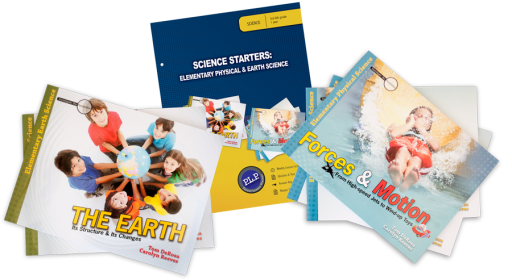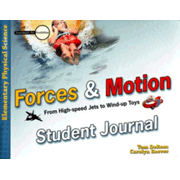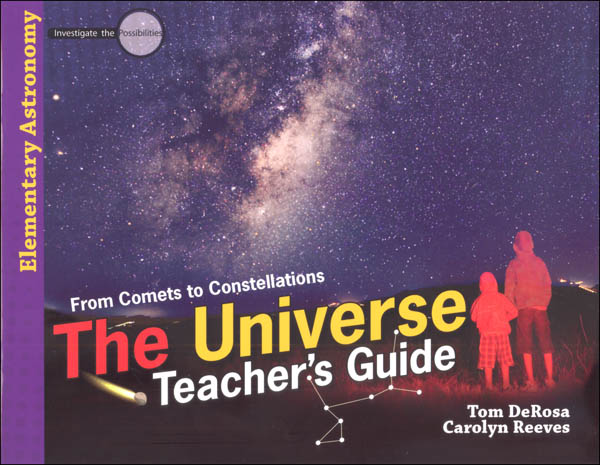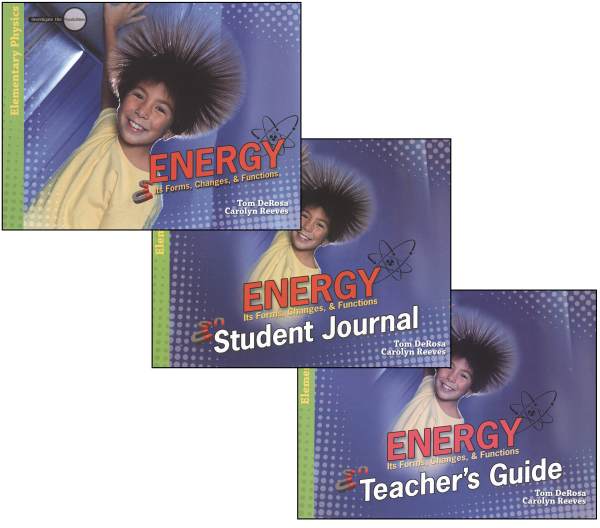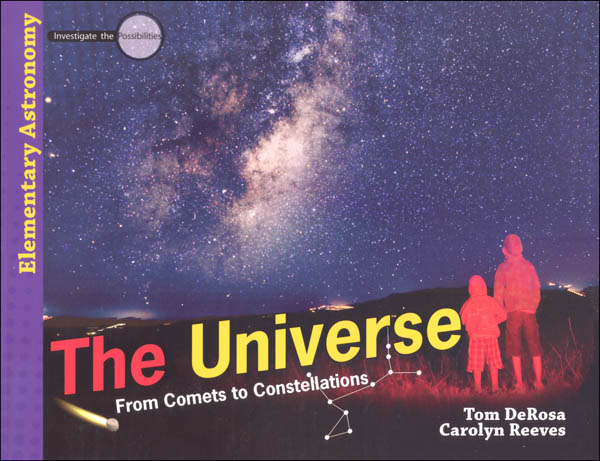Master Books has published a series of six science courses for grades three through eight that feature a biblical Christian worldview, solid science content, and hands-on activities. The courses are:
- The Earth, Its Structure & Its Changes: Elementary Earth Science
- Forces & Motion: Elementary Physical Science
- Matter: Elementary Chemistry
- Energy: Elementary Physical Science
- Water & Weather
- The Universe
Each course should take about a semester to complete, so any two of the courses together provide a full-year curriculum. I've purposely grouped the courses into three groups of two courses each since Master Books has published guides that work with them in these groupings. A Science Starters Parent Lesson Planner (PLP) covers each group of two courses. Science Starters: Elementary Physical & Earth Science Parent Lesson Planner guides you through The Earth and Forces & Motion. Science Starters: Elementary Chemistry & Physics Parent Lesson Planner covers Matter and Energy. Science Starterss: Elementary General Science & Astronomy takes you through Water & Weather and The Universe.
The groups of courses can be used in any order you like, but I think The Earth and Forces & Motion seem best for starting with third or fourth graders, and The Universe and Water and Weather should probably be saved for last. While two of the PLPs state that the courses are for grades three through six, I would judge them to be best for grades four through eight.
A biblical Christian worldview underlies all of the content in the texts. They teach a young-earth perspective. However, the biblical connections are more subtle in some of the books than others. They are built into narratives such as one about how different scientists pursue knowledge and into other features such as the biographical sketches of famous scientists. All of the books present creationist arguments against evolutionary theories, but some topics invite more controversy. For example, Water and Weather spends time on fossils and the Flood, The Earth uses the eruption of Mt. St. Helen and its aftermath to buttress creationist arguments for a young earth.
The content for these books is based primarily on the National Science Education Standards for grades five through eight, although some content reflects standards for kindergarten through fourth grade. In contrast to most science textbooks, these courses take a narrower focus on fewer topics and cover them extensively. The courses cover earth science, space science, physical science and chemistry. Master Books also publishes separate Elementary Anatomy and Elementary Zoology courses which can be used together for a full year course. Using all of these courses covers all of the broad areas of science for four years.
Lessons begin by raising a question and having children do an “investigation.” Some investigations are relatively simple (e.g., marking latitude and longitude lines on and orange, then cutting along some lines to make it into a flat map) while others are quite complex (e.g., constructing and experimenting with a small catapult). After students have become engaged in the topic, they read “The Science Stuff” that teaches the lesson content. “Dig Deeper” follows with suggestions for a number of follow up activities, many of them research oriented, but some directing students to pursue activities or experiments. Older students should pursue some or all of the Dig Deeper activities, but younger students should have plenty of learning activity with the core lesson. Lessons end with “What did you learn?” questions that review lesson content including the investigation. Students should be completing about one lesson per week and there are 20 in each course.
Lessons sometimes suggest comparison of student results, implying a group setting. While students are likely to have more fun sharing the investigations with other students, they could still work individually with a parent. The design of the lessons and activities actually lends itself better to home education settings than to traditional classrooms since there is more opportunity for discussion and it will be easier to complete the investigations which support the “inquiry” methodology of this program. It is also easier to guide only one or a few students through choosing and completing “Dig Deeper” activities. This series really does a nice job of addressing various learning styles, but some of that benefit is dependent upon taking time to choose which activities work best for students, activities such as research on the internet, creation of a timeline, and hands-on projects.
For experiments and activities you will need to collect quite a few resources such as safety glasses, C-clamps, light bulbs, mirrors, clothespins, a metal slinky, Epsom salt, six-volt battery, sandpaper, plastic film canisters, plastic tubing, balloons, and screws—most of which can be found in local stores. Some items such as a graduated cylinder and spring force measure might need to be ordered from science suppliers. Plan ahead since some items might not be readily available or might take a little time to locate.
In addition to the Parent Lesson Planner (PLP) for groups of courses, there are three components for each course: Student Text, Student Journal, and Teacher’s Guide. All are very attractively presented in softcover books. The Student Text is printed in full color with at least fifty percent of the space taken up with illustrations. The Student Journal, printed in black-and-white, also features an attractive graphic design. The Journal serves as a place for students to record observations and conclusions from the investigations. Charts are included when appropriate. A boxed area is set aside for “Dig Deeper” reporting although I expect that students might sometimes need more space than is allowed here. “What did you learn?” questions are repeated here with space for answers. The Teacher’s Guide has reduced reproductions of Student Text pages in black-and-white, although these are sometimes difficult to read because of the original colors of the text and graphics running behind them. The Teacher’s guides have brief introductory information on the course followed by reproduced text pages accompanied by objectives, brief notes, and answer keys. Note that for The Earth the publisher experimented by combining the Teacher’s Guide and Student Journal into a single book with perforated Journal pages for easy removal. I suspect most parents and students will prefer the separate journal format of the other courses.
Step-by-step instructions make it easy for the parent without a strong scientific background to teach these courses. However, significant preparation and presentation time are required. While parents and teachers will use the Teacher's Guides for lesson presentation, the PLPs provide detailed schedules, lists of supplies needed, quizzes and tests, and answer keys. Quizzes and tests may be reproduced for up to ten students. PLPs are not essential, but they are very helpful if you want help with scheduling and plan to use quizzes and tests.
The combination of solid science content with a biblical Christian worldview and hands-on activity makes this series a great choice for many home educators. The approach is likely to engage students in ways that help them learn and remember the information better than with traditional textbooks.

